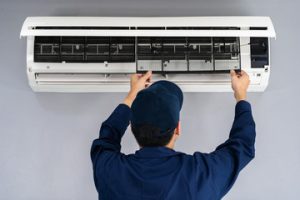AIR CONDITIONING REPLACEMENT LOVELAND OH ensures reliable cooling during hot seasons. Old units may struggle to maintain consistent temperatures. New systems improve efficiency and reduce energy costs. Timely replacement prevents sudden breakdowns.

Frequent repairs can indicate it’s time for replacement. Components wear out over time, affecting performance. Constant malfunctions increase maintenance costs. Replacing the system is often more economical.
Modern air conditioners use advanced refrigerants for efficiency. Upgrading improves environmental safety and reduces emissions. New systems cool spaces faster and more evenly. Energy savings are significant over time.
Improved airflow is a key benefit of replacement. Ducts and vents work more effectively with updated units. Proper circulation enhances comfort in every room. Balanced airflow reduces strain on the system.
Older systems often lack smart technology. New units integrate with programmable thermostats and remote controls. Smart features allow energy optimization and convenience. Users can monitor and adjust cooling easily.
Noise reduction is another advantage of replacement. Old units produce rattling, humming, or buzzing sounds. Modern systems operate quietly. Peaceful operation improves indoor comfort significantly.
Air quality improves with new air conditioners. Advanced filters remove dust, allergens, and pollutants. Better ventilation reduces respiratory issues. Clean air enhances overall health and comfort.
Sizing is critical during replacement. Oversized units cycle on and off frequently, wasting energy. Undersized units struggle to cool spaces effectively. Professionals calculate optimal size for efficiency.
Energy efficiency standards have evolved. New air conditioners meet stricter regulations. High-efficiency units consume less electricity. Lower energy bills and reduced environmental impact are key benefits.
Ductwork may need adjustment during replacement. Leaky or old ducts reduce efficiency and airflow. Sealing or updating ducts improves performance. Proper installation maximizes cooling output.
Refrigerant type impacts performance and compliance. Modern systems use environmentally friendly refrigerants. Proper handling during replacement prevents leaks and hazards. Compliance supports long-term sustainability.
System lifespan affects replacement decisions. Units approaching the end of life lose efficiency. Frequent repairs signal imminent failure. Upgrading ensures consistent cooling and reliability.
Maintenance becomes easier with new systems. Components are accessible and designed for durability. Cleaning and inspections take less time. Reduced maintenance effort saves homeowners money and hassle.
Zoning capabilities enhance replacement benefits. Separate areas can have independent temperature control. Energy is not wasted cooling unused spaces. Personalized comfort is a major advantage.
Thermostat accuracy improves with replacement. Older units often have inconsistent temperature readings. New systems maintain precise indoor temperatures. Accurate control enhances comfort and efficiency.
Humidity control is better with modern air conditioners. Excess moisture can cause discomfort and mold growth. Replacement systems regulate humidity more effectively. This creates a healthier indoor environment.
Installation quality affects long-term performance. Proper setup prevents leaks, electrical issues, and inefficiency. Technicians ensure correct placement and alignment. Correct installation extends system lifespan.
Air conditioner replacement supports home value. Updated HVAC systems are attractive to buyers. Energy-efficient systems reduce operational costs. Modern units signal reliability and comfort.
Emergency replacement may be necessary during extreme heat. A failing system can leave spaces dangerously warm. Rapid replacement restores comfort and safety. Professional service ensures proper setup under pressure.
Smart diagnostics are common in new air conditioners. Sensors detect problems before they escalate. Early alerts prevent costly repairs. Proactive maintenance is easier with advanced monitoring.
Outdoor unit placement affects efficiency. Proper positioning improves airflow and cooling performance. Shaded and ventilated locations maximize energy savings. Professional guidance ensures optimal placement.
Refrigerant line and coil condition may require replacement. Worn lines or dirty coils reduce efficiency. Technicians inspect and replace components as needed. Proper repair ensures peak performance of the new system.
Seasonal energy savings are greater with replacement. New units consume less electricity in high-demand months. Reduced load on the grid lowers environmental impact. Homeowners enjoy lower utility bills consistently.
Replacement often includes warranty coverage. Protecting the system against defects ensures peace of mind. Manufacturers offer parts and labor support. Warranty reduces long-term repair costs.
Eco-friendly options are available during replacement. High-efficiency and low-emission units reduce carbon footprint. Sustainable cooling supports environmental responsibility. Choosing eco-conscious systems benefits everyone.
System reliability increases after replacement. Fewer breakdowns and consistent performance improve comfort. Advanced components reduce failure risks. Homeowners gain confidence in their cooling system.
Proper sizing and installation prevent uneven cooling. Rooms at the far end of ducts often experience temperature differences. Replacement ensures balanced airflow and consistent comfort. Efficient design minimizes hot or cold spots.
Retrofitting older homes requires careful planning. Ducts, electrical supply, and structural constraints must be addressed. Professionals adapt systems to fit existing layouts. Proper integration ensures maximum efficiency.
Energy audits complement replacement decisions. Evaluating insulation, windows, and duct integrity enhances system performance. Upgrades improve cooling efficiency and reduce energy waste. Comprehensive planning ensures long-term benefits.
Replacement improves dehumidification and condensation management. Modern systems handle moisture better than older models. Proper drainage prevents water damage and mold. Comfortable, safe indoor conditions are maintained.
Home automation enhances new air conditioners. Integration with smart home hubs allows remote scheduling and control. Energy consumption can be monitored and optimized. Convenience and savings are combined.
Noise and vibration are reduced with modern compressor technology. Variable-speed compressors adjust to demand quietly. Smooth operation increases comfort. Less mechanical stress prolongs system life.
Replacement may involve upgrading insulation around ductwork. Proper insulation reduces heat gain or loss in airflow. Efficiency and cooling performance are enhanced. Long-term energy savings are significant.
Professional installation ensures correct refrigerant charge. Incorrect levels reduce efficiency and lifespan. Technicians measure and adjust accurately. Proper charging maximizes system performance.
Air conditioner replacement addresses aging electrical components. Worn wiring, fuses, and breakers are replaced. Safe and reliable power supply is maintained. Electrical upgrades prevent hazards and outages.
Remote monitoring allows predictive maintenance. Sensors detect irregular performance or efficiency drops. Early intervention prevents costly repairs. Predictive service increases system longevity.
Replacement enhances home comfort overall. Even temperatures, clean air, and reliable operation improve quality of life. Energy savings reduce financial stress. Modern systems provide consistent, worry-free cooling.
System aesthetics improve with new air conditioners. Sleek indoor units complement home interiors. Outdoor units are more compact and less obtrusive. Modern design integrates seamlessly with living spaces.
Proper duct sealing and balancing are part of replacement. Uneven airflow or leaks reduce efficiency. Technicians adjust systems to distribute air evenly. Balanced airflow ensures comfort throughout the home.
Advanced air filtration is included in many new systems. HEPA or activated carbon filters improve indoor air quality. Dust, pollen, and odors are effectively removed. Healthy air supports overall well-being.
Replacement ensures compliance with updated regulations. Older units may no longer meet efficiency or safety standards. New systems adhere to current codes. Compliance guarantees safe, efficient operation.
Regular checkups after replacement maintain performance. Inspecting refrigerant, filters, and components prevents degradation. Professional service ensures consistent cooling. Long-term reliability is supported.
Emergency situations are minimized with replacement. Modern units are less prone to sudden failure. Built-in diagnostics prevent unnoticed issues. Homeowners gain confidence in year-round cooling.
Energy efficiency ratings help homeowners compare systems. SEER and EER ratings indicate performance. Choosing high-rated units reduces consumption and costs. Efficiency is a key benefit of replacement.
Replacement improves reliability during peak heat. Old units may struggle under high demand. Modern systems maintain steady operation. Consistent cooling prevents discomfort and system stress.
Furnace and air conditioner integration enhances home comfort. Coordinated heating and cooling improves overall climate control. System efficiency is maximized. Replacement supports seamless operation.
Noise, energy efficiency, smart features, airflow, and safety all improve with replacement. Modern air conditioners offer consistent cooling and better performance. Professionals ensure proper installation and optimization. Replacement protects comfort, health, and finances.




